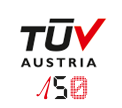TÜV AUSTRIA uses analytical procedures, modern testing methods and extensive experience to prevent injury and damage that can result in unplanned outages with expensive repairs and possible consequential costs. Systematic risk analyses and methodical procedures are used to identify risk potential and develop action plans.
TÜV AUSTRIA saves time, nerves and money:
As an old saying goes: “Getting hurt makes you smart.” Unexpected damage may make you smarter, but certainly also poorer. The aim of TÜV AUSTRIA’s work is to prevent injury and damage and thus costs by means of preventive measures.
With on-stream measuring methods and state-of-the-art analysis procedures, diagnosis is carried out of incipient damage caused by continuous stress. This allows conclusions to be drawn about the time span for safe continued operation of a plant or the need to undertake a replacement investment in good time. If, on the other hand, damage has occurred, it will be analyzed with great care so that the necessary action can be taken quickly to prevent any repetition.
A special service for the insurance industry is assessment of a company’s risk potential. TÜV AUSTRIA’s experts get to the bottom of causes in cases of damage or impending damage. Together with the customer, they develop strategies and solutions for avoiding problems in the future.
What does TÜV AUSTRIA provide?
Hazard and risk analyses of technical plants and processes:
The aim of a risk analysis is to obtain a general overview of existing risks and, if necessary, to identify any need for action. Consideration is given to effects on people, the environment and property which may be caused by divergences from normal operation.
Risk management:
Systematic evaluation of the following key factors influencing safety, security and availability, doing so as a basis for identifying and reducing risks: equipment integrity, technical risk analysis, procedures and workflows, training and education, legislative compliance, management of opportunity, maintenance, contingency planning, learning from incidents of injury and damage.
Risk based Inspection (RBI) of pressurized components:
Specific definition of required inspections and tests of pressurized components as a function of the harmful mechanisms at work and the consequences of a failure.
Identification of local inadmissible heating:
This is done using, for example, thermographic methods for electrical controls, bearings and other rotating parts so as to prevent possible damage to the plant.
Failure analysis of components and materials using materials science investigations such as metallographic investigations based on properly taken samples:
Conventional metallography and scanning electron microscopic examinations (SEM, EDX analyses) are used, including micro- and low-load hardness tests as well as metal analysis (optical emission spectrometry), microscopic and macroscopic examinations of fracture surfaces. Investigations into corrosion damage.
Component metallography, i.e., microstructural investigations of components themselves without taking samples using replica technology, underpinned by accompanied by mobile hardness testing, mobile metal analysis and wall thickness measurements done by ultrasound.
Computational verification of components in accordance with relevant regulations and the latest state of knowledge:
TÜV AUSTRIA’s experts have a large number of state-of-the-art computer programs at their disposal running on powerful computers. Mechanical and thermal loads can be traced and evaluated using complex simulation programs.
Risk analyses for the insurance industry:
Analyses of damaging events in the area of machinery breakdowns and in electrical installations are not only important for reasons pertaining to insurance contract law, but they also serve to prevent damage. Preventive risk analyses for harm prevention are equally important.
... all the way to risk analysis of large-scale plants, such as determining explosion risks at oil refineries, the Competence Center for Plant Diagnostics and Damage Analysis covers the entire spectrum of preventive and subsequent damage analysis.
Advantages provided by TÜV AUSTRIA:
TÜV AUSTRIA has the largest pool of field-proven experts in Austria. This means that tailor-made solutions can be developed and implemented even for complex problems.
- Close interdisciplinary cooperation between our experts means that our customers have access to the entire knowledge of all of TÜV AUSTRIA’s fields of expertise.
- TÜV AUSTRIA’s test reports, certificates and expert opinions are recognized by customers and public authorities worldwide.
- State-of-the-art test methods, precise test planning and adherence to schedules minimize downtimes and save costs.
- For more than 135 years, business and industry have been working successfully and in a spirit of trust with TÜV AUSTRIA in the service of safety and technical development.
- TÜV AUSTRIA has a large network of competent partners worldwide.

